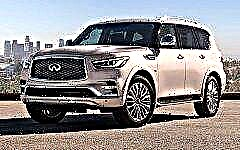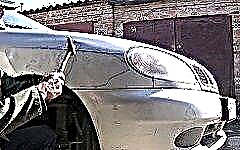
Many car owners who find themselves in an accident and are faced with deformation of body parts are interested in effective methods of correct body straightening. If, after such an incident, serious defects appear on the body, such as dents, partial damage to the paint layer, etc., it is necessary to immediately restore the previous condition of the car. For the upcoming work, it will be necessary to prepare a number of tools and specialized equipment.
Paintless ways to remove dents

Before starting the practical part of the restoration of the damaged wing, inspect the defective place. If the depth of the dent is small, and significant creases are not observed, or the paintwork has not been broken, it is not advisable to carry out the traditional straightening, as this will damage the paintwork and you will have to completely repaint the wing.
To avoid additional costs, it is enough to use paint-free straightening methods:
- Magnetic technology. To carry out the work, you need to prepare a magnet and hold it from the end of the defect closer to the central part. During the procedure, you must pull the magnet towards you. To avoid violating the paintwork, it is better to place a fabric backing under the product. You can use a flannel and fleece napkin.
- Straightening levers. The body pulling method is called PDR and is a highly advanced solution for dealing with defects of various sizes. Wing restoration in this way presupposes the presence of several products with a curved ring. To gain access to the damage, you need to remove the wing. Straightening is carried out with a hook with a suitable length, with a careful impact on the problem area. If you follow all the rules of the procedure and be careful, the surface will be leveled.
- Applicators. Applicators are used to restore the vehicle wing from the outside. The defective area must be carefully prepared by treating it with a degreasing agent and cleaning it from dirt. In the central part, fix the applicators and wait for the glue to harden. The center of the damage is carefully pulled out and checked for other defects. To work, you need a mini-lifter or a bracket with screw-in fasteners. After finishing the work, the remnants of the glue mixture must be removed.
- Straightening without staining is done by heating, after which the surface is cooled. The action is easy to implement without outside help, by preparing a construction or assembly hair dryer, as well as an aerosol with compressed air. It is necessary to warm up the problem area with a hairdryer and create an air flow from the can. Under the influence of the temperature jump, the defective zone will be leveled. If the defect is of medium size, it is heated in different places.
If you find scratches, bends and other defects in the paintwork, you need to perform a traditional straightening with painting the wing.
Straightening tools

Body restoration by straightening is a rather narrow-profile and painstaking action that can be performed only with experience and specialized equipment. To carry out the procedure, you will need to prepare:
- straightening hammers with different boilies
- inertia-free rubberized hammers;
- stamps and anvils for fixing the wing;
- cloth for processing metal products;
- straightening spoons for removing sheets;
- sandpaper and grinder;
- files for servicing non-volumetric bulges;
- spotter for leveling the structure by spot welding.
For a successful straightening, it is better to prepare several straightening hammers of different types. You also need a basic locksmith tool, which should be at the disposal of every car owner.
To implement the work, it is worth placing the wing on a flat structure treated with batting, felt or padding polyester to suppress impacts. The surface can be leveled by light tapping with various hammers. With the presence of special tools, the wing is securely fixed in a stationary state.
When straightening, additional protection of other nodes will not interfere. To do this, use a front attachment with a magnetic surface and a cutout under the wing. A good help for straightening can be a spotter, which is a special device that works on the principle of resistance welding. Heat energy appears in the welded area, and the tool has a point effect. To remove dents, you need to prepare a reverse hammer.
Wing painting and straightening with putty

If, when eliminating defects in the wing of the car, the old paint and varnish layer is broken or peels off, you will need to repaint the structure. Wing painting is done according to the same principles as painting other body elements:
- A putty solution is applied to the damaged area with a spatula. The number of layers is chosen empirically until the surface is leveled. All subsequent coatings are applied only after the previous layer has dried.
- When the finishing layer hardens, you need to wipe the surface with sandpaper or a grinder;
- Spray or brush the primer;
- Next, the coating needs to be painted with a spray gun or a paint brush. The topcoat is protected with varnish or polish.
Wing painting is also in demand in the presence of minor defects with damage to the paintwork. The base must be leveled with a putty, then primed and painted.
Advantages of using a magnetic cape when straightening a car yourself

When performing repair and maintenance work affecting body parts, it is important to prevent damage to nearby vehicle parts. A special magnetic cover is suitable for protecting the body. It is designed to protect the paintwork from any defects.
A wear-resistant material (usually vinyl) is used for the manufacture of the cape. Such a cape has several advantages:
- has high strength and wear resistance;
- easily and reliably fixed, does not slide out or fall;
- the material absorbs shocks with high quality;
- There are a variety of magnetic cape options available on the market, including cut-out wing protectors.
On sale you can find capes for specific models and brands of the car. If you have experience in sewing, you can sew a cape with your own hands. In this case, you will save a decent amount of money. For manufacturing you will need:
- dense denim or synthetic winterizer;
- cutting and measuring tools (scissors, centimeter, paper);
- sewing machine;
- three magnets for fastening.
First of all, you should take measurements and form a paper pattern. Next, you need to lay out the denim fabric on a suitable flat place and cut out 2 canvases of fabric and 1 layer of padding polyester, which will be used to absorb shocks. The synthetic winterizer must be sewn between the layers of the jeans to secure the fastening magnets.
Working with internal parts

Straightening the internal body parts is considered a fairly straightforward job. If you have the necessary tools and locksmith skills, you can do the procedure yourself, especially when it comes to aligning spars and beams. The main difficulties can arise when working with areas of conjugation of damaged structures - a doorway with doors, a mudguard with a hood, an engine shield with a frame, etc.
Forming a straight line at the junction of parts requires special skill.In addition, many actions require preliminary restoration of geometry, and this is already a separate, very crucial stage.
It takes professional tools and equipment to bring back the correct geometry. At the same time, modern cars are subject to deformations even with minor accidents. For example, if the attachment points of the components have moved, it is necessary to eliminate this as soon as possible, since the vehicle will move "at an angle" or the engine will begin to come into contact with the body structure. Sometimes defects can be corrected with their own hands by replacing individual body fragments. But in other cases, it has to be pulled out with the help of special equipment, which is accompanied by a number of difficulties.
Straightening by tapping and pulling the hook

The work is accompanied by a high investment of time and effort, since you have to dismantle the body in the damaged area, and then mark the area of the dent. To tap out defects, a support surface is needed. An anvil is suitable for this.
Sometimes you have to slightly heat the metal to make it soft.
The second method involves removing dents with hooks. This is practiced for larger body defects. The process is carried out according to a simple algorithm: a self-tapping screw is screwed into the center of the problem area, and then the bend is pulled out with hammer blows until the treated area returns to its original position. Self-tapping marks can be painted over or treated with putty.
Stretched metal shrinkage

Stretched metal surfaces, after straightening, become higher than the rest of the parts, and also lose their safety margin and become unstable. Metal cannot be tapped with a hammer or lowered due to lack of free space. The surface either deforms, going in the opposite direction, or returns to its original place.
If you managed to eliminate the deformation using the right tools and the right force, then the stretched metal will appear only in the area where the defect is located. If the restoration was carried out without a thorough assessment of the condition of the surfaces, the problem will worsen, and traces of metal stretching will appear throughout the entire plane.
To return the material to its original state, you will need to determine the highest stretch point and warm it up with a specialized tool. Then it is necessary to place a support under the heated area and make several hammer blows on the hot metal. As a result, it will shrink and the heated spot will become thicker.
Finally, cool the area with a sponge or wet rag. A similar method will allow other areas to be seated. But the main thing is to be careful and not overdo it. Otherwise, the surface will deform and other problems will arise.
Heat shrinkage is carried out taking into account the following rules:
- the reverse side of the heated zone must be cleaned of a layer of noise insulation;
- during shrinkage, a support with a smaller bulge should be used than the stretched metal;
- an acetylene torch with a nozzle is suitable for most applications. You can also get by with the method of heating by semi-automatic welding or carbon electrode;
- using an acetylene torch, you need to warm the base to a bright red color;
- it is impossible to cool the metal, which has warmed up to a red color. Better to wait for it to cool down and turn black;
- avoid heating the area to the point that you cannot hammer it down in one go. The burner manages to warm up an area from 10 to 25 mm;
- when heating, it is forbidden to allow circular movements in a spiral and from the periphery to the center;
- shrinkage cannot be done until the metal is straightened to its original state;
- the defective area must not be heated to shrink;
- if the problem area is small, you need to warm up a small spot;
- the stretched material shrinks without cooling;
- after shrinkage, additional leveling of the base is used.
Conclusion
If you decide to straighten the body yourself, be prepared to take into account both the positive aspects of your choice, and some pitfalls and unpleasant moments. Even if this stage is completed successfully, do not forget that it is followed by another difficult job, namely painting the body. And the cost of painting can unpleasantly surprise you, especially if mistakes were made during straightening.

|| list |
- Paintless ways to remove dents
- Straightening tools
- Wing painting and straightening with putty
- Advantages of using a magnetic cape when self-straightening a car
- Working with internal parts
- Straightening by tapping and pulling the hook
- Stretched metal shrinkage











